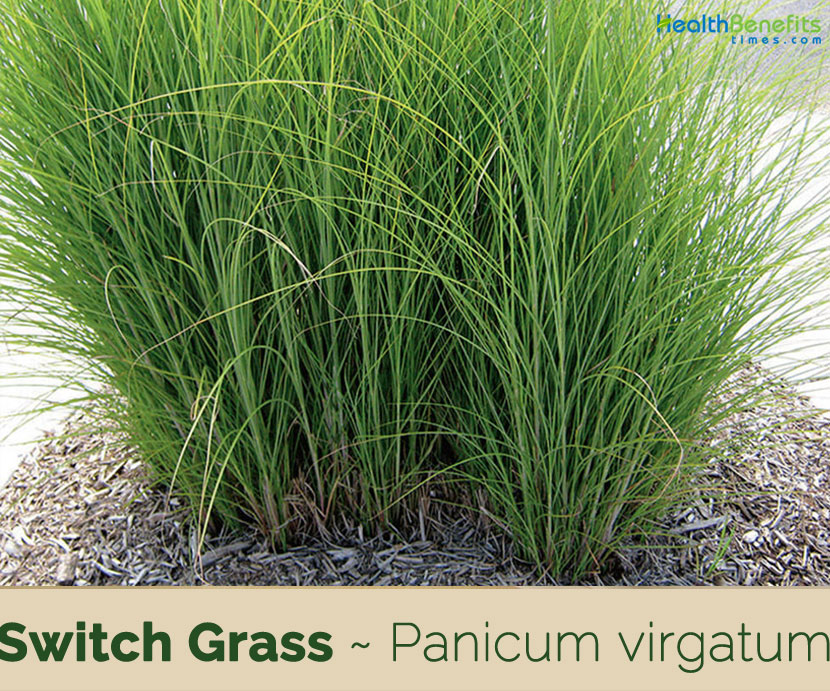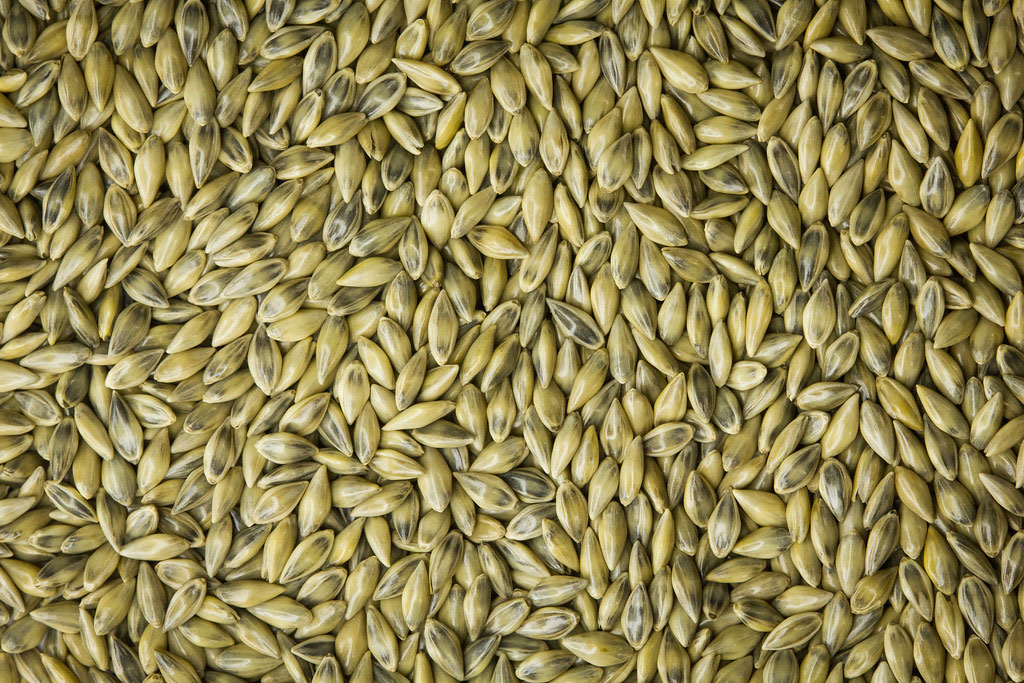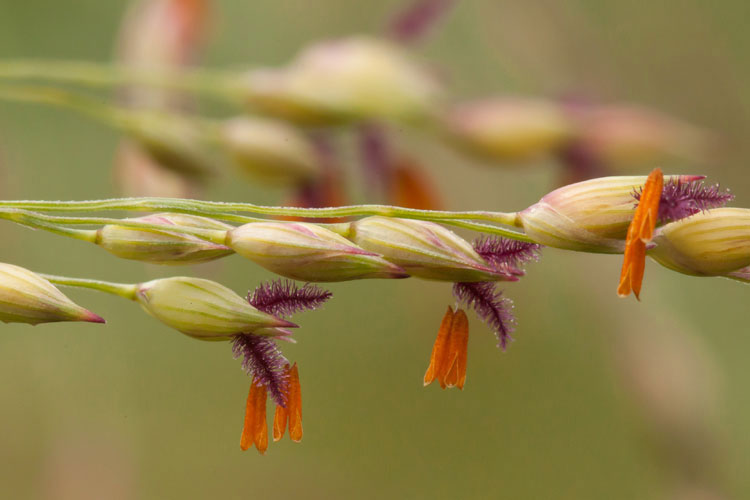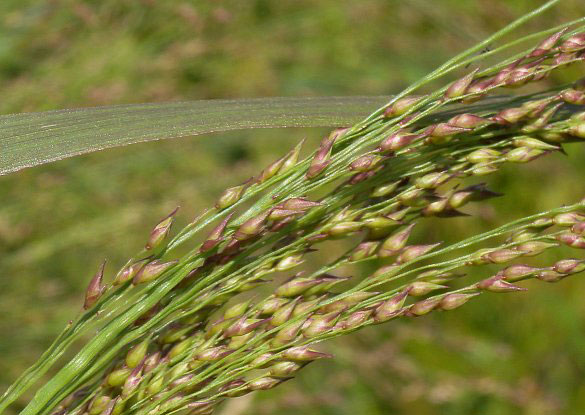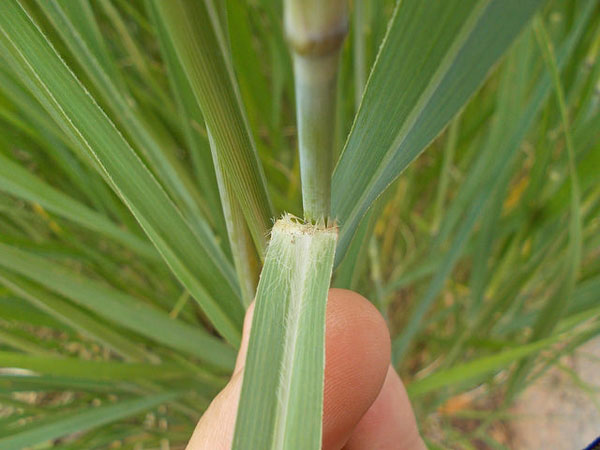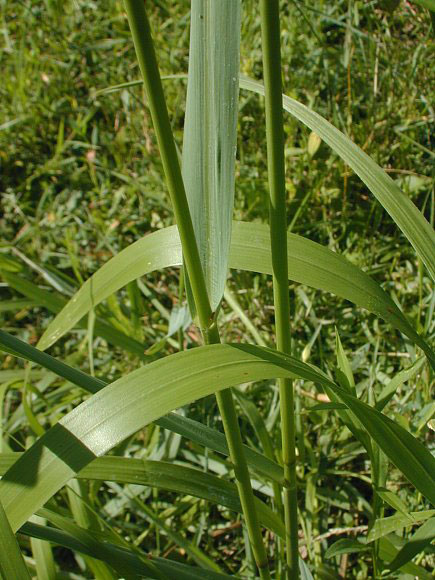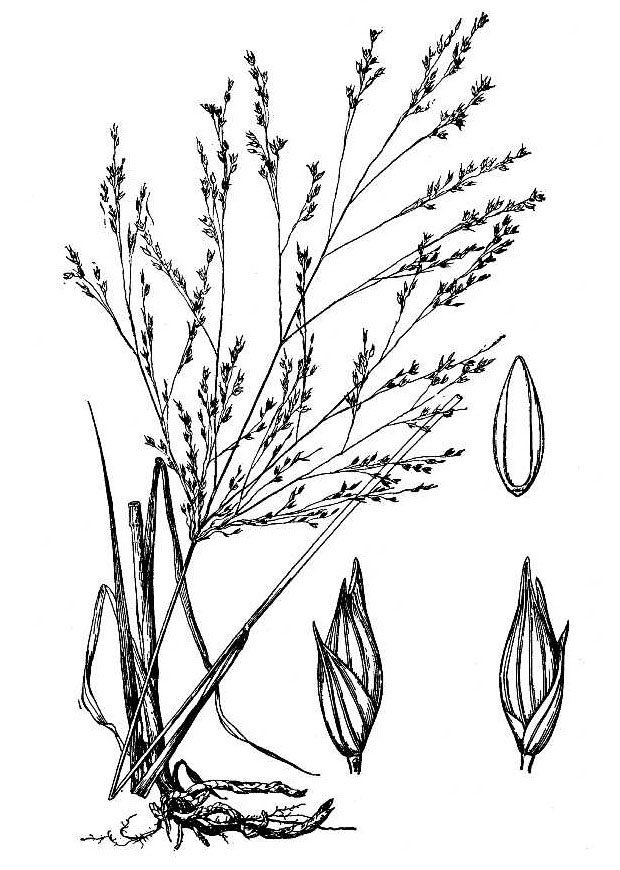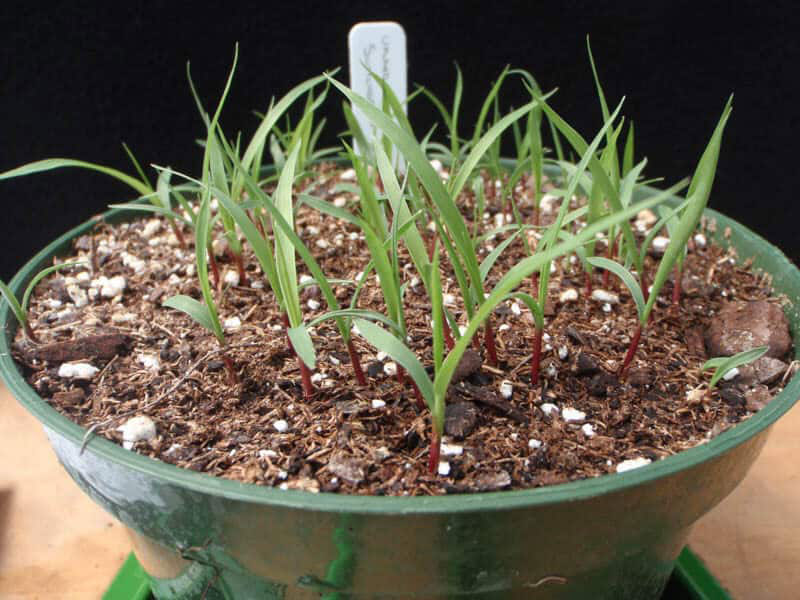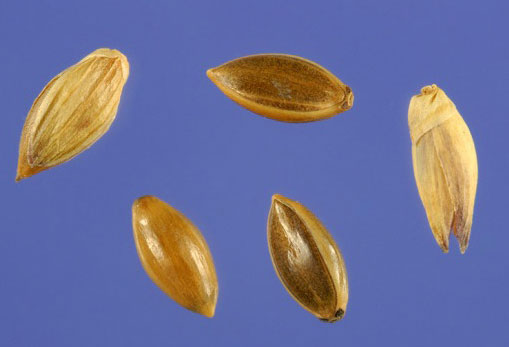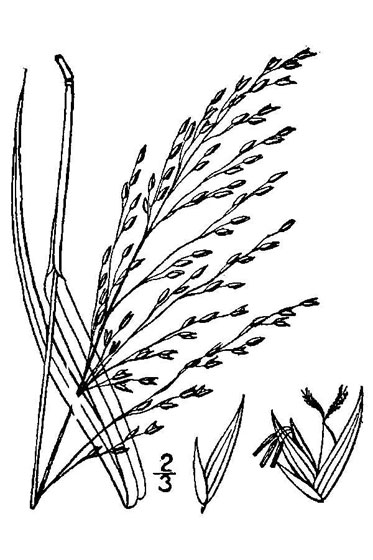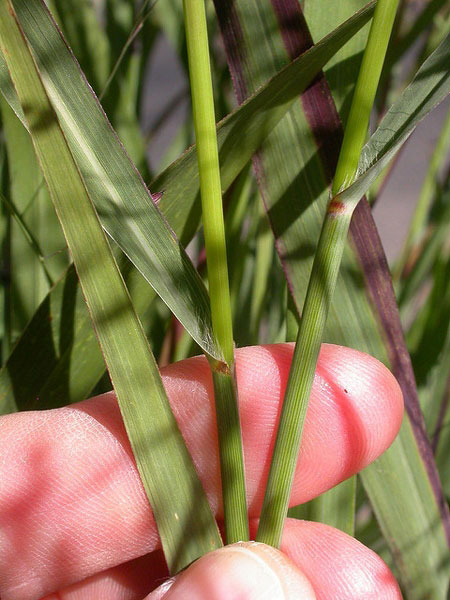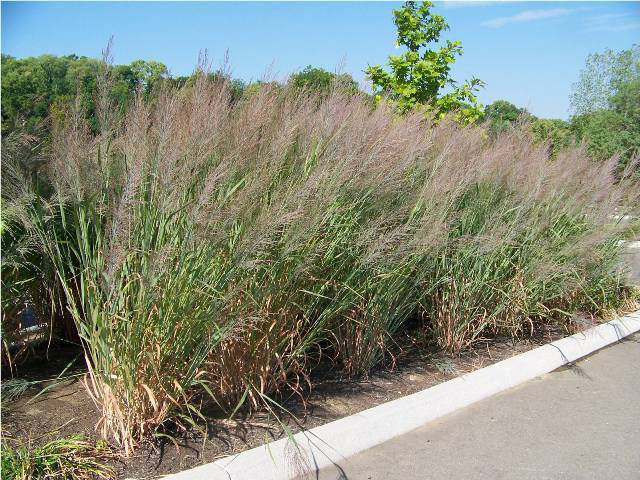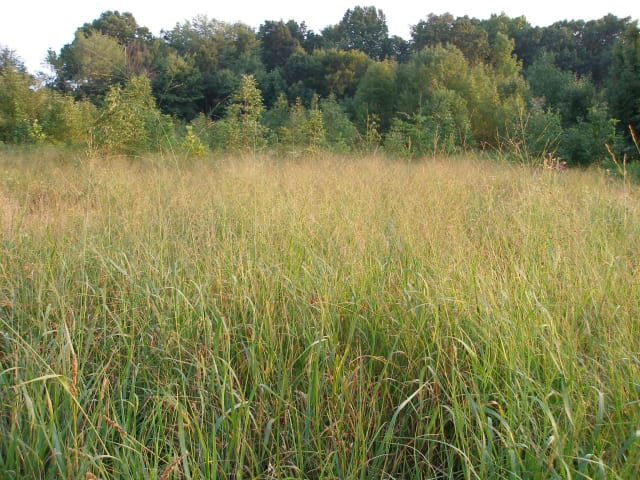Plant Description
Switch grass is a hardy, deep-rooted, clump forming, warm season, perennial, rhizomatous bunchgrass that grows about 2.7 m (8 ft. 10 in) high, but is typically shorter than big bluestem grass or Indian grass. It is a warm season grass that is capable of thriving in wide range of environments. The plant is found growing in black soil prairies, clay prairies, sand prairies, typical savannas, sandy savannas, open woodlands, rocky bluffs, sand dunes, edges of marshes, sandy pannes, banks of rivers and ponds, prairie restorations, areas along railroads, roadsides, ditches, abandoned fields, gravel bars, stream banks, open oak and pine woodlands, shores, riverbanks, and high brackish marshes along maritime forest. The plant prefers moderately deep to deep, somewhat dry to poorly drained, sandy to clay loam soils are best. It does poorly on some heavy soils. In the East, it performs well on shallow and droughty soils. It may flop in overly rich soils. The plant has deep rhizomatous and fibrous root system nearly as deep as the plant is tall. Culms are light to medium green (less often light blue and glaucous), terete, glabrous, and fairly stout. Stem is round and can have a red to straw colored tint.
Leaves
Several alternate leaves occur along the entire length of each culm. Their blades are ascending to widely spreading. The leaf blades are up to 15 mm. across and 2 inches long. They are usually medium green (less often light blue and glaucous), hairless to mostly hairless, and either flat or slightly indented along their mid veins. Leaf sheaths are about the same color as the blades and hairless. They are open at their apices, forming a V-shape. Ligules have bands of white hairs, while the nodes are swollen and often dark-colored.
Flowers & seed
Each fertile culm terminates in an inflorescence that is 7-20 inches long and about one-half as much across when it is fully open. This inflorescence is an airy panicle of spikelets. It is broader toward the bottom than the top and pyramidal in outline. Along the rachis (central stalk) of the inflorescence, there are either solitary lateral branches or pseudo-whorls of 2-3 lateral branches. The ascending to widely spreading branches divides into branchlets and pedicellate spikelets. Rachis, lateral branches, branchlets, and pedicels are light green (rarely light blue and glaucous), glabrous, and slender. They are straight, slightly curved, or slightly wiry. During the period of bloom, the spikelets are 3-5 mm. long, light green to reddish green (rarely light blue and glaucous), lanceoloid in shape, and glabrous.
Each spikelet has 2 glumes, 2 lemmas (one fertile and the other sterile), a palea, and a perfect floret. The smaller glume is about two-thirds of the length of the spikelet, while the remaining glume and sterile lemma are the same length as the spikelet. The glumes and sterile lemma are ovate, convex along their outer surfaces, longitudinally veined, and narrowly acute at their tips. The fertile lemma is 2.5–3.5 mm. long, ovate, convex along its outer surface, vein less, membranous, and acute at its tip. Flowers have a well-developed panicle, often up to 60 cm long, and it bears a good crop of seeds. The seeds are 3–6 mm long and up to 1.5 mm wide, and are developed from a single-flowered spikelet. Both glumes are present and well developed. When ripe, the seeds sometimes take on a pink or dull-purple tinge, and turn golden brown with the foliage of the plant in the fall. Seeds are a food source for birds in winter.
Types
Some commonly available ornamental cultivars include:
Blue Tower
It is up to 8 feet tall in flower, with blue-green leaves selected by Crystal Palace Perennials of Illinois.
Cloud Nine
It is a tall selection introduced by former Bluemount Nursery of Maryland that can reach 7-8 feet, with light metallic blue leaves and gold fall color. It makes a good substitute for some of the larger Miscanthus cultivars.
Dallas Blues
It is a 5 foot tall selection originally found in Dallas and introduced by Change of Scenery Nursery in Columbus, Ohio. It has powdery blue leaves that turn copper in fall and remain well colored through the winter, and pinkish-purple flower plumes. The leaves are wider than many other cultivars, and plants have a fuller shape and denser flower spikes that appear in distinct layers. It is more drought tolerant than many cultivars.
Heavy Metal
It is a Kurt Bluemel introduction with tightly upright cool blue-green leaves that turn rich amber in fall and fade to light tan by winter. The compact plants are only about three feet tall, with taller flower spikes with strong pink tones, and dark burgundy seeds.
Northwind
It is a vigorous, very upright selection by Roy Diblik at Northwind Perennial Farm in Lake Geneva, Wisconsin, growing up to 5 feet tall with steel blue foliage that turns tawny gold in fall, and maroon and green flower plumes held incredibly erect above the foliage.
Prairie Fire
It is from Amber Wave Gardens, Benton Harbor, Michigan has green foliage that turns shades of deep red in early summer. It is much earlier than other red cultivars and butter yellow in fall. The upright clumps grow 4-5 feet tall and 1½-2 feet wide. The leaves curl slightly when the rosy panicles appear.
Prairie Sky
It is discovered growing wild in a Wisconsin meadow, it is one of the bluest selections (but not as sturdy as some so may flop more in wet conditions) that grows 4-5 feet tall, with silvery inflorescences.
Shenandoah
It is a German selection that grows 3½-4 feet tall and has red leaf tips early in the growing season and burgundy fall foliage color with burgundy seed heads.
Other Facts
- It is a valuable soil-stabilization plant; it is used as ground cover to control erosion.
- It can be used as an energy substitute and is often considered a good candidate for bio-fuel, especially ethanol fuel production, due to its hardiness against poor soil and climate conditions, rapid growth and low fertilization and herbicide requirements.
- The plant is sometimes used as a windbreak in crop fields.
- Switch grass is excellent forage for cattle; however, it has shown toxicity in horses, sheep, and goats.
- It provides good warm-season pasture and high quality hay for livestock.
- Switch grass uses C4 carbon fixation, giving it an advantage in conditions of drought and high temperature.
- Switch grass is both a perennial and self-seeding crop, which means farmers do not have to plant and reseed after annual harvesting.
- Once established, switch grass stand can survive for ten years or longer.
References:
https://www.itis.gov/servlet/SingleRpt/SingleRpt?search_topic=TSN&search_value=40913#null
https://davesgarden.com/guides/pf/go/2634/
https://npgsweb.ars-grin.gov/gringlobal/taxonomydetail.aspx?id=26657
https://pfaf.org/user/Plant.aspx?LatinName=Panicum+virgatum
https://www.missouribotanicalgarden.org/PlantFinder/PlantFinderDetails.aspx?kempercode=l460
https://plants.usda.gov/core/profile?symbol=PAVIV
http://www.theplantlist.org/tpl1.1/record/kew-430831
https://gd.eppo.int/taxon/PANVI
https://en.wikipedia.org/wiki/Panicum_virgatum
https://www.fs.fed.us/database/feis/plants/graminoid/panvir/all.html
Comments
| Switch Grass Quick Facts | |
|---|---|
| Name: | Switch Grass |
| Scientific Name: | Panicum virgatum |
| Origin | Across eastern and central North America except California and the Pacific Northwest |
| Colors | Pink or dull-purple tinge, and turn golden brown with the foliage of the plant (Seed) |
| Shapes | 3–6 mm long and up to 1.5 mm wide, and are developed from a single-flowered spikelet (Seed) |
| Name | Switch Grass |
|---|---|
| Scientific Name | Panicum virgatum |
| Native | Across eastern and central North America except California and the Pacific Northwest |
| Common Names | Tall panic grass, Wobsqua grass, blackbent, tall prairiegrass, wild redtop, thatchgrass, Virginia switchgrass |
| Name in Other Languages | Afrikaans: Draakplant Albanian: Terragoni Arabic: طرخون Armenian: T’arkhun (թարխուն) Azerbaijani: Tərxun Basque: Binagrera Belarusian: эстрагон Bengali: Tārāgana (তারাগন) Bokmål: Estragon Bosnian: Estragon Breton: Stragon Bulgarian: тарос Catalan: Estragon, Estragó, Herba vinagrera Chinese: Liu zhi ji Corsican: Arba dragona Czech: Pelyněk estragon Danish: Estragon Dutch: Dragon English: Blackwell switch grass, Switch grass, Old switch panic grass, Wand panicgrass, Wild tarragon, tarragon, French Tarragon Esperanto: Estragono Estonian: Vitshirss, Estragon, Estragonpuju Finnish: Rakuuna French: Panic érigé, Panic vierge, Panic raide, Panic dressé, Estragon, Estragonu, millet vivace Galician: Estragon Georgian: T’arkhuna (ტარხუნა) German: Rutenhirse, Estragon, rutenförmige Hirse Greek : Estrankón (εστραγκόν) Hebrew : לענה דרקונית Hungarian: Tárkony Ido: Estragono Indonesian: Tarragon Irish: Dragan Italian: Panico vergato, Dragoncello o estragone, Assenzio dragoncello, Estragone Japanese: Taragon (タラゴン) Kazakh: Sırğaljıñ (шырғалжың) Kirghiz: Sıraaljın şıbak (шыраалжын шыбак) Kurdish: Tarxûn Lithuanian: Vaistinis kietis Macedonian: Estragon (естрагон) Malay: Tarragon Manx: Dragane Norwegian Nynorsk: estragon Occitan: Estragon Ossetian: мæзæрæу Punjabi: Taraḵẖōna (ਤਰਖ਼ੋਨ) Persian: ترخون Polish: Bylica draganek, proso rózgowate Portuguese: Estragão Romanian: Tarhon Russian: Proso loznoe, estragon (эстрагон) Serbian: Estragon (естрагон) Slovak: Palina dračia Slovenian: Pehtran Spanish: Cortadero Swedish: Jungfruhirs, dragon Turkish: Tarhun Ukrainian: тархун Uzbek: Sherolgʻin Welsh: Taragon |
| Plant Growth Habit | Hardy, deep-rooted, clump forming, warm season, perennial, rhizomatous bunchgrass |
| Growing Climates | Black soil prairies, clay prairies, sand prairies, typical savannas, sandy savannas, open woodlands, rocky bluffs, sand dunes, edges of marshes, sandy pannes, banks of rivers and ponds, prairie restorations, areas along railroads, roadsides, ditches, abandoned fields, gravel bars, stream banks, open oak and pine woodlands, shores, riverbanks, and high brackish marshes along maritime forest |
| Soil | Moderately deep to deep, somewhat dry to poorly drained, sandy to clay loam soils are best. It does poorly on some heavy soils. In the East, it performs well on shallow and droughty soils. May flop in overly rich soils |
| Plant Size | About 2.7 m (8 ft. 10 in) high, but is typically shorter than big bluestem grass or Indian grass |
| Root | Deep rhizomatous and fibrous root system nearly as deep as the plant is tall |
| Culms | Light to medium green (less often light blue and glaucous), terete, glabrous, and fairly stout |
| Stem | Round and can have a red to straw colored tint |
| Leaf | 30–90 cm (12–35 in) long, with a prominent midrib. leaves turn to golden in autumn |
| Flowering season | August through October |
| Flower | Flowers have a well-developed panicle, often up to 60 cm long, and it bears a good crop of seeds |
| Fruit Shape & Size | Beautiful reddish-purple seed head atop glossy leaves |
| Seed | 3–6 mm long and up to 1.5 mm wide, and are developed from a single-flowered spikelet |
| Seed Color | Pink or dull-purple tinge, and turn golden brown with the foliage of the plant |
| Propagation | By division in spring |


